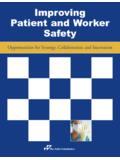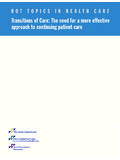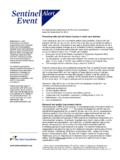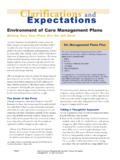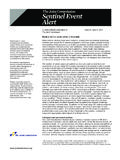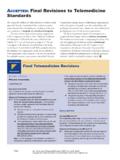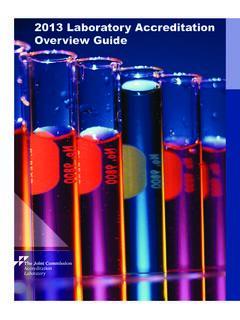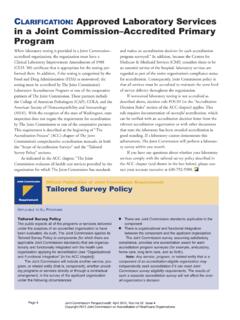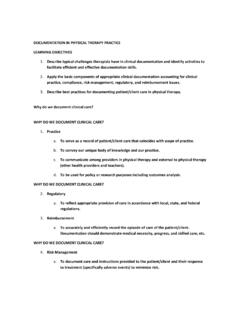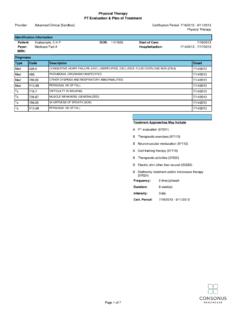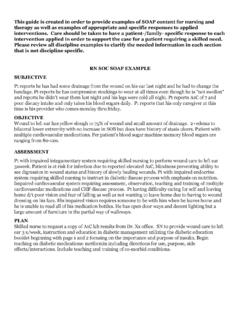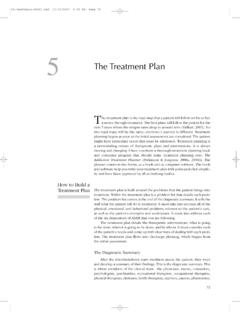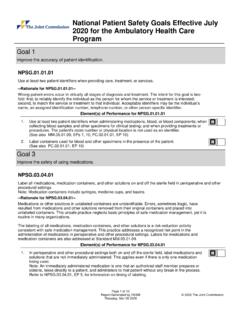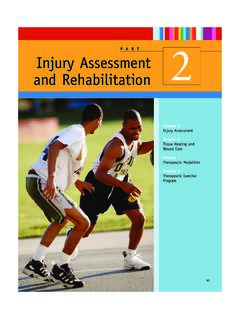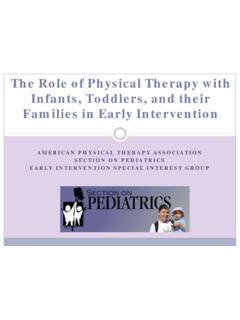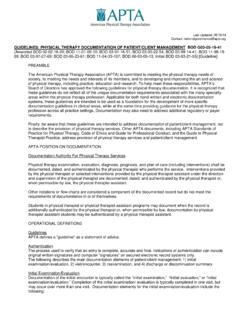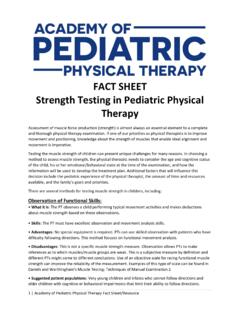Transcription of National Patient Safety Goals Effective July 2020 for the ...
1 National Patient Safety Goals Effective July 2020 for the Critical Access Hospital Program Goal 1. Improve the accuracy of Patient identification. Use at least two Patient identifiers when providing care, treatment, and services. --Rationale for Wrong- Patient errors occur in virtually all stages of diagnosis and treatment. The intent for this goal is two- fold: first, to reliably identify the individual as the person for whom the service or treatment is intended;. second, to match the service or treatment to that individual.
2 Acceptable identifiers may be the individual's name, an assigned identification number, telephone number, or other person-specific identifier. Newborns are at higher risk of misidentification due to their inability to speak and lack of distinguishable features. In addition to well-known misidentification errors such as wrong Patient /wrong procedure, misidentification has also resulted in feeding a mother's expressed breastmilk to the wrong newborn, which poses a risk of passing bodily fluids and potential pathogens to the newborn.
3 A reliable identification system among all providers is necessary to prevent errors. Element(s) of Performance for 1. Use at least two Patient identifiers when administering medications, blood, or blood components; when collecting blood samples and other specimens for clinical testing; and when providing treatments or procedures. The Patient 's room number or physical location is not used as an identifier. (See also , EP 10). 2. Label containers used for blood and other specimens in the presence of the Patient .
4 (See also , EP 10). 3. Use distinct methods of identification for newborn patients . Note: Examples of methods to prevent misidentification may include the following: - Distinct naming systems could include using the mother's first and last names and the newborn's gender (for example: Smith, Judy Girl or Smith, Judy Girl A and Smith, Judy Girl B" for multiples). - Standardized practices for identification banding (for example, using two body sites and/or bar coding for identification). - Establish communication tools among staff (for example, visually alerting staff with signage noting newborns with similar names).
5 Page 1 of 15. Report Generated by DSSM 2020 The Joint Commission Thursday, Mar 26 2020. National Patient Safety Goals Effective July 2020 for the Critical Access Hospital Program Goal 2. Improve the effectiveness of communication among caregivers. Report critical results of tests and diagnostic procedures on a timely basis. --Rationale for Critical results of tests and diagnostic procedures fall significantly outside the normal range and may indicate a life-threatening situation. The objective is to provide the responsible licensed caregiver these results within an established time frame so that the Patient can be promptly treated.
6 Element(s) of Performance for 1. Develop written procedures for managing the critical results of tests and diagnostic procedures that address the following: - The definition of critical results of tests and diagnostic procedures - By whom and to whom critical results of tests and diagnostic procedures are reported - The acceptable length of time between the availability and reporting of critical results of tests and diagnostic procedures 2. Implement the procedures for managing the critical results of tests and diagnostic procedures.
7 3. Evaluate the timeliness of reporting the critical results of tests and diagnostic procedures. Goal 3. Improve the Safety of using medications. Label all medications, medication containers, and other solutions on and off the sterile field in perioperative and other procedural settings. Note: Medication containers include syringes, medicine cups, and basins. --Rationale for Medications or other solutions in unlabeled containers are unidentifiable. Errors, sometimes tragic, have resulted from medications and other solutions removed from their original containers and placed into unlabeled containers.
8 This unsafe practice neglects basic principles of safe medication management, yet it is routine in many organizations. The labeling of all medications, medication containers, and other solutions is a risk-reduction activity consistent with safe medication management. This practice addresses a recognized risk point in the administration of medications in perioperative and other procedural settings. Labels for medications and medication containers are also addressed at Standard Element(s) of Performance for 1. In perioperative and other procedural settings both on and off the sterile field, label medications and solutions that are not immediately administered.
9 This applies even if there is only one medication being used. Note: An immediately administered medication is one that an authorized staff member prepares or obtains, takes directly to a Patient , and administers to that Patient without any break in the process. Refer to , EP 5, for information on timing of labeling. Page 2 of 15. Report Generated by DSSM 2020 The Joint Commission Thursday, Mar 26 2020. National Patient Safety Goals Effective July 2020 for the Critical Access Hospital Program 2. In perioperative and other procedural settings both on and off the sterile field, labeling occurs when any medication or solution is transferred from the original packaging to another container.
10 3. In perioperative and other procedural settings both on and off the sterile field, medication or solution labels include the following: - Medication or solution name - Strength - Amount of medication or solution containing medication (if not apparent from the container). - Diluent name and volume (if not apparent from the container). - Expiration date when not used within 24 hours - Expiration time when expiration occurs in less than 24 hours Note: The date and time are not necessary for short procedures, as defined by the critical access hospital.
